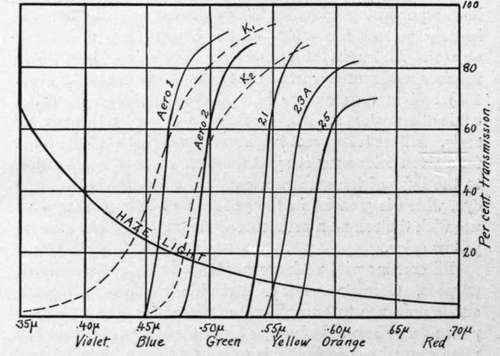Chapter XIX. Filters. The Function Of Filters In Aerial Photography
Description
This section is from the book "Airplane Photography", by Herbert E. Ives. Also available from Amazon: Airplane photography.
Chapter XIX. Filters. The Function Of Filters In Aerial Photography
The use of color screens or filters has been very common in ordinary landscape photography, for the purpose of securing approximately correct renderings of the brightnesses of colored objects. Plates of the non-color-sensitive type have their maximum of sensitiveness in the blue of the spectrum (Fig. 105) and in consequence blue skies photograph as white, while other colors are likewise reproduced on a totally wrong scale. Filters for correct brightness rendering are calculated for a given color sensitive plate so that the resultant reaction to the light of the spectrum copies the sensitiveness of the eye, which is greatest in the yellow-green. Such filters for use with the common orthochromatic plates are of a general yellow color.
Filters for aerial work are meant to serve quite a different purpose. Correct tone or color rendering is of quite secondary importance to another use of filters, namely, to cut or pierce aerial haze. It is quite a matter of accident that the same general color of filter is called for both to give correct color rendering and to pierce aerial haze, namely, yellow. Yet on closer analysis it is found that quite different types of yellow filter are demanded, spectroscopically considered.
Figure 106 (Ki and K2) shows the spectral transmission curves of the Wratten Ki and K2 filters, intended for correct color rendering with orthochromatic plates. The absorption increases gradually toward the blue. In the same figure is shown on an arbitrary scale the spectroscopic character of typical haze illumination, increasing in brightness inversely as the fourth power of the wave-length, that is, with great rapidity in the blue and violet. It is evident from this that a much more abrupt absorption than that of the Ki or K2 filter is desirable, because in the green of the spectrum the haze light is comparatively weak, and more will be lost by any absorption in this region through decreasing useful photographic action than will be gained by cutting out the haze. This latter consideration is important. The use of any filter means an increase of exposure; the use of yellow filters multiplies it several times. Careful experiment has shown that no filter of depth less than K1^, to use the Wratten filters as a basis for discussion, are of real value in haze piercing. The filter ratio, or ratio of exposures with and without filter, is 4.7 for the K li with the Cramer Isonon plate—a figure which shows the importance of securing the necessary haze-piercing character with the minimum absorption of useful photographic light.

Fig. 106. - Characteristics of various filters.
Continue to:
Tags
camera, lens, airplane, aerial, film, exposure, photography, maps, birdseye
